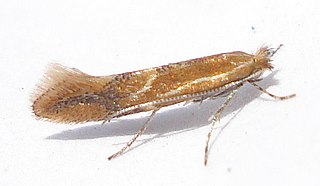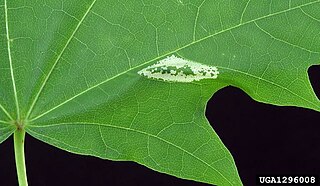
Gracillariidae is an important family of insects in the order Lepidoptera and the principal family of leaf miners that includes several economic, horticultural or recently invasive pest species such as the horse-chestnut leaf miner, Cameraria ohridella.

Phyllonorycter is a genus of moths in the family Gracillariidae.

Phyllonorycter joannisi is a moth of the family Gracillariidae. It is found in most of Europe.
Phyllonorycter baetica is a moth of the family Gracillariidae. It is found in Spain and France.
Phyllonorycter troodi is a moth of the family Gracillariidae. It is known from Cyprus.
Phyllonorycter triflorella is a moth of the family Gracillariidae. It is known from France, Corsica, Sardinia, Italy and Croatia.
Phyllonorycter cytisella is a moth of the family Gracillariidae. It is endemic to the Canary Islands and is known from Gran Canaria, La Palma, and Tenerife.
Phyllonorycter cytisifoliae is a moth of the family Gracillariidae. It is endemic to the Canary Islands and is known from Gran Canaria, La Palma, and Tenerife.

Phyllonorycter foliolosi is a moth of the family Gracillariidae. It is endemic to the Canary Islands and is known from La Palma and Tenerife.
Phyllonorycter helianthemella is a moth of the family Gracillariidae. It is found from Germany to the Iberian Peninsula, Italy and Greece and also on the Canary Islands.

Phyllonorycter hilarella is a moth of the family Gracillariidae. It is found in all of Europe, except the Balkan Peninsula and the Mediterranean Islands.
Phyllonorycter insignitella is a moth of the family Gracillariidae. It is found in all of Europe, except the Balkan Peninsula.
Phyllonorycter juncei is a moth of the family Gracillariidae. It is known from the Canary Islands and Madeira.
Phyllonorycter lapadiella is a moth of the family Gracillariidae. It is known from Croatia, Serbia, Greece, France, Italy and Sicily.
Phyllonorycter medicaginella is a moth of the family Gracillariidae. It is found from Denmark and Poland to Belgium, the Alps, Bulgaria and Ukraine.

Phyllonorycter nigrescentella is a moth of the family Gracillariidae. It is known from all of Europe except the Balkan Peninsula.
Phyllonorycter pseudoplataniella is a moth of the family Gracillariidae. It is known from France and Germany.

Phyllonorycter spinicolella, also known as the sloe midget, is a moth of the family Gracillariidae, first described by the German entomologist Philipp Christoph Zeller in 1846. It is probably present in all of Europe.

Phyllonorycter staintoniella is a moth of the family Gracillariidae. It is found from Sweden to the Pyrenees, Sardinia, Italy and Bulgaria and from Great Britain to Poland and Romania.

Lithocolletinae is a subfamily of insects in the moth family Gracillariidae. It is distributed worldwide, with most species in temperate regions.





